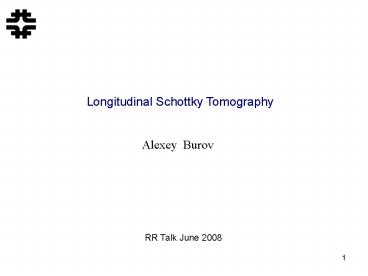Longitudinal Schottky Tomography - PowerPoint PPT Presentation
1 / 17
Title:
Longitudinal Schottky Tomography
Description:
This algorithm is realized in MathCad. ... The MathCad code looks ready for translation into a routinely working console application. ... – PowerPoint PPT presentation
Number of Views:25
Avg rating:3.0/5.0
Title: Longitudinal Schottky Tomography
1
Longitudinal Schottky Tomography
Alexey Burov
RR Talk June 2008
2
General integral equation
- Longitudinal Schottky signal gives distribution
function over the energy offset . - The energy and time offsets are
canonically conjugated values, with the
Hamiltonian - where is the effective mass,
is the RF Voltage, and is the
revolution time. - The measured momentum distribution
relates to an unknown 2D phase space distribution
as - Solution of this equation gives the phase space
density f .
3
Rectangular Barrier Bucket (RBB)
For this potential well, the original integral
equation transforms into differential form for
the integral distribution
4
Solution of the Integral Equation for RBB
- This equation can be solved starting from
high Hamiltonians, where the shifted functions
, leading
to
Then, a recursive algorithm is applied to find
the function at any smaller Hamiltonian value
5
Resulting Phase Space Density
- With this solution, the integral phase space
density is found - Here is a time period for the
longitudinal motion as a function of the
Hamiltonian E - with
are inside the bucket and - outside velocities, is
acceleration inside the barriers.
6
Realization in Mathcad
- Data from Dan (PA1964, 5/29/2008 338 PM)
Regular decline of the tails indicates no
background has to be worried about.
7
Resulting Integral Phase Space Distribution F(H)
8
Calculated Schottky
- Found distribution can be used to calculate
expected Schottky signal, and then compare it
with the original data, checking the solution
Red line calculated Schottky Blue dots
original data Brown line DC contribution
9
Conclusions
- Integral equation for the longitudinal Schottky
tomography is solved for an arbitrary rectangular
barrier bucket. An exact solution is found in a
form of recursive analytical procedure with a
small number of steps. - This algorithm is realized in MathCad. The code
is tested for a Gaussian distribution, the
correct result was found. - The code was applied for real Schottky data, the
phase space distribution was obtained. In
particular, a fraction of the DC beam was found
2.4 times more compared to the naïve estimation. - A calculated Schottky signal agrees with the
initial data. - The MathCad code looks ready for translation into
a routinely working console application.
10
3.3 hr of cooling
6/12/08, 1336
6/12/08, 1657
Same Pbar beam, same bunch length. Cooling
results in the tails.
11
Beam squeezing, R37 data of June 19/2008 (Lionel)
DC Prediction for Tsep16.4 µs
DC Prediction for Tsep15.26 µs
Initially the beam was 6.4 us, then it was
squeezed to 5.26 us. Time between the two data
sets is 5 min. Back DC prediction is very
accurate, while the forward one overestimates DC
1.7 times. It looks as the distribution of DC
changes for that 5 min.
12
Dependence on the frequency span
Comparison of 40 and 50 KHz spans For the same
distribution (f_0/245 KHz). While the far
tails start to differ, the DC portions are close
3.8E-3 vs 4.3E-3.
Schottky data for these two measurements
13
Stretching-Squeezing (data June 24, Lionel)
DC calculations for Tsep15.83 µs 3.0E-3 vs
2.9E-3
843 -gt
DC Prediction for Tsep15.83 µs
DC Prediction for Tsep17.35 µs
8.52 -gt
Problem while narrow-to-wide prediction works
with good accuracy, Wide-to-narrow prediction
overestimates DC 2 times.
14
Stretching-Squeezing (cont)
Red 5.83µs direct analysis (as above) Blue
7.35µs-based calculation for 5.83µs
Red 7.35µs direct analysis (as above) Blue
5.38µs-based calculation for 7.35µs
15
Dependence on RF Value
The tree plots show how the direct
calculation and prediction depend on the
assumed RF value.
16
Ultimate cases of T1sep
Red 0.72µs direct analysis Blue 9.24µs-based
calculation for 0.72µs
Red 9.24µs direct analysis Blue
0.72µs-based calculation for 9.24µs
17
Conclusions
- The tomography results were cross-checked by
comparing direct calculations with the
predictions based on other width of the
potential well (other T1sep). The two
distributions are normally coincided at the core
and far tails, but disagree by a factor of 2 at
the AC-DC boundary. - The calculated distribution is shown to be very
sensitive to RF 5 of the RF amplitude leads to
factor of 2 change of the DC portion. - I guess that the cross-check disagreement relates
to 5 difference of the real and model
(rectangular barrier bucket) RF.































